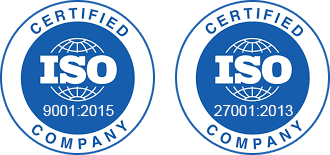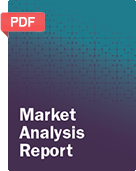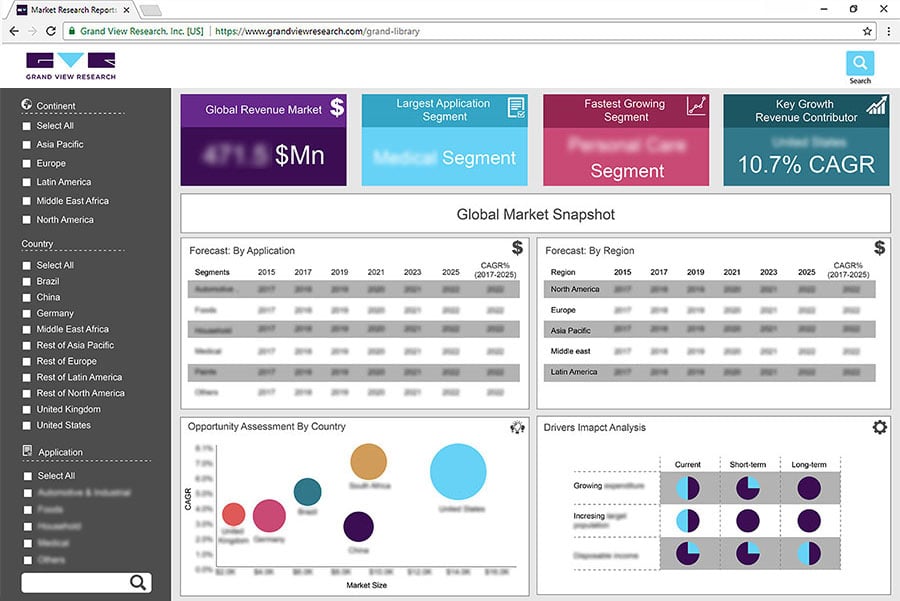- Home
- »
- Medical Devices
- »
-
Small Molecule Innovator CDMO Market Size Report, 2030GVR Report cover
![Small Molecule Innovator CDMO Market Size, Share & Trends Report]()
Small Molecule Innovator CDMO Market Size, Share & Trends Analysis Report By Product (Small Molecule API, Small Molecule Drug Product), By Stage Type, By Customer Type, By Therapeutic Area, By Region, And Segment Forecasts, 2024 - 2030
- Report ID: GVR-4-68039-908-0
- Number of Report Pages: 119
- Format: PDF, Horizon Databook
- Historical Range: 2018 - 2022
- Forecast Period: 2024 - 2030
- Industry: Healthcare
Market Size & Trends
The global small molecule innovator CDMO market size was estimated at USD 48.6 billion in 2023 and is expected to expand at a compound annual growth rate (CAGR) of 6.21% from 2024 to 2030. Key drivers for this growth are increasing pharmaceutical R&D investment, growing demand for small molecules, and rising incidence of cancer & age-related disorders. Biological drugs are more expensive than small molecules. Hence, growing demand for cost-effective drugs is expected to further support market growth.
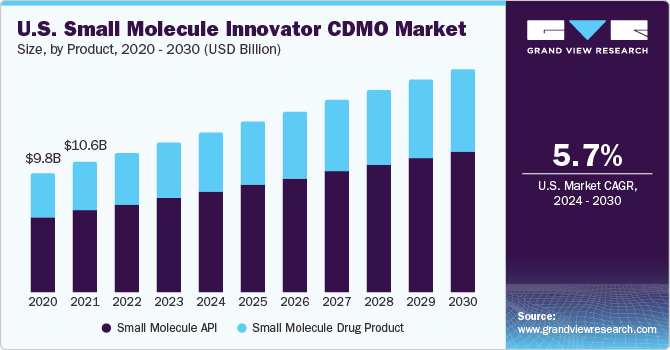
The COVID-19 pandemic significantly impacted on global economy in 2020 and caused an ongoing impact on various industries. However, the market for contract development and manufacturing organization (CDMO) witnessed a positive impact due to this pandemic. CDMOs played an important role in meeting the needs of pharmaceutical companies, biotech companies, and other end-users during this crisis. Overall, pandemic boosted market demand for small molecule innovator drugs. With the growing demand for outsourcing by pharma companies, heightened demand is observed in post-pandemic scenario.
Market Dynamics
Expansion of small molecule innovator CDMO industry is being driven by an increase in cancer incidences and a rise in the demand for effective diagnosis & R&D for oncology procedures. According to the WHO, cancer is the leading cause of death globally, with approximately 10 million estimated fatalities in 2020. High burden of cancer is expected to support the demand for innovative cancer drugs and promote market demand throughout the forecast period.
Product Insights
The product segment is segmented into small-molecule API and small molecule drug. Small molecule API segment accounted for the largest revenue share of 61.64% in 2023. This growth can primarily be attributed to a rise in demand for small molecule innovators. Furthermore, in recent years, the U.S. FDA has approved a significant number of new APIs. For instance, in 2022, the FDA approved 52 new molecular entities in the U.S. Similar approvals in the future are expected to support segmental growth.
The segment also includes small molecule drug, which is expected to grow at a CAGR of 5.68% during the forecast period. Small molecule drug delivery solutions have become increasingly sophisticated, and regulatory standards have become strict to ensure patients receive a higher level of quality & efficacy. Not all companies have well-equipped facilities to manufacture commercial products. As a result, they are subject to many laws and inspection intervals, among other things. Partnering with a reputable CDMO with well-maintained GMP facilities, a proven regulatory track record, and a strong quality system can greatly reduce regulatory risks. This is expected to accelerate segment growth.
Stage Type Insights
Based on stage type, the market is segmented into preclinical, clinical, and commercial. Clinical stage segment is estimated to hold largest revenue share of 55.0% in 2023. There is significant number of small molecule drugs among clinical stage. Apart from this, there is constant surge in R&D spending on drugs. For instance, according to the report of World Preview, total R&D spending on drugs accounted for USD 238.0 billion in 2022, and by 2028, it is expected that total R&D spending on drugs is expected to reach 285.0 billion. Thus, surge in R&D spending is expected to increase clinical segment growth.
The commercial segment is projected to register fastest CAGR of 6.85% over the forecast period. Rising demand for outsourcing by small- and medium-sized pharmaceutical companies is one of the major factors driving segment growth. Small molecules accounted for 75% of the 53 NMEs approved in 2020. A similar trend in small molecule drug approvals is expected to promote the segment growth. There is significant number of commercially available small molecule innovator drugs. To focus on the core expertise, pharmaceutical companies are expected to outsource manufacturing activities of small molecule innovator drugs to specialized CDMO; this is expected to further support segment growth.
Therapeutic Area Insights
Based on therapeutic area, the market is segmented into cardiovascular diseases, oncology, respiratory disorder, neurology, metabolic disorders, infectious diseases, and others. The oncology segment held the largest share of 42.09% in 2023. Increasing number of cancer cases globally, significant government reimbursement policies, and rise in financing for the development of small molecule oncology therapies are other factors boosting segment growth.
A significant number of cancer drugs are in product pipeline. For instance, according to the pharmaceutical R&D annual review, in 2022, oncology accounted for the majority of clinical trials totaling 16,000. High number of studies in this therapeutic area supports segment growth.
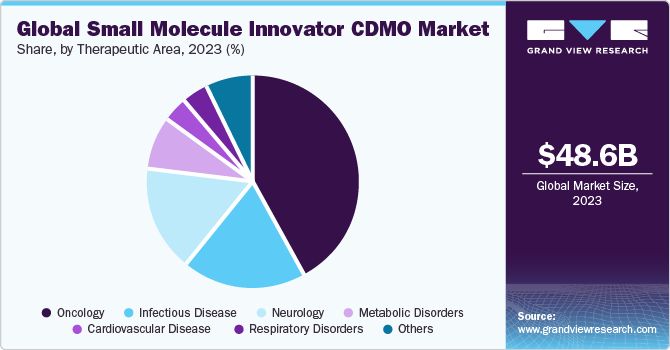
Infectious diseases segment is expected to grow at a CAGR of 6.42% over the forecast period. Every year, new, potentially hazardous bacteria, viruses, fungi, and parasites arise, such as SARS (severe acute respiratory syndrome). Infectious diseases are third leading cause of death in the U.S., accounting for over 170,000 deaths each year. Infectious infections are the second leading cause of death worldwide, with over half of all deaths occurring in children under the age of five.
Existing diseases, as well as new and emerging ones, pose a constant threat to the global population. Growing disease burden of infectious disease will boost small molecule innovators CDMO industry demand, which, in turn, is likely to propel overall market growth during the forecast period.
Customer Type Insights
Based on customer type, the market is segmented into pharmaceutical companies and biopharmaceutical companies. The pharmaceutical segment accounted for a revenue share of 93.98% in 2023. An increase in the number of new small molecule drug launches worldwide is one of the key factors supporting segment growth.
There is a growing interest among pharmaceutical companies to focus on core competencies and outsource non-core activities like drug manufacturing and development; owing to this reason, CDMO is actively expanding its manufacturing facilities. For instance, in May 2022, Catalent, Inc. expanded its U.S. manufacturing facility producing large-scale oral doses. Such expansions are expected to increase collaborations between the CDMO and pharmaceutical companies to manufacture small molecule innovator drugs and thus support the market growth.
The biotechnology segment is expected to grow with a CAGR of 4.62% across the forecast period. The rapid advancement of biopharmaceutical research and technology opens new opportunities for generating small-molecule drugs that are both innovative and creative. In recent years, advancements in prediction, structure-based design, and imaging, as well as automation, artificial intelligence, and machine learning, have become major enablers for small molecule-led optimization to increase speed and enhance success rates.
Regional Insights
Asia Pacific accounted for the largest revenue share of 42.45% in 2023. Advancements in technology, low cost of services, and availability of skilled workforce at a lower cost than developed economies, are anticipated to propel regional market growth. Increasing regulatory focus on quality control for manufacturing is one of the key factors expected to drive regional market growth over the forecast period.
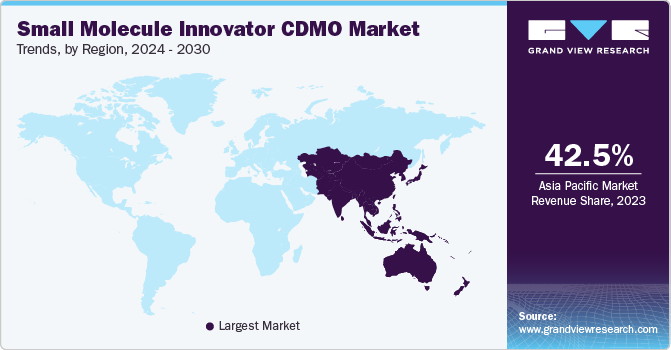
Asia Pacific has several regulatory agencies, such as the Pharmaceuticals and Medical Devices Agency (PMDA) in Japan; the Ministry of Food and Drug Safety (MFDS) in South Korea; the Therapeutic Goods Administration (TGA) in Australia; and the Singapore Health Sciences Authority (HSA) in Singapore. These organizations ensure that drugs produced in respective countries are of high quality. This further supports regional market growth.
North America is expected to grow at a CAGR of 5.61% during the forecast period. It is one of the major contributors to the small molecule API innovator Contract Development & Manufacturing Organization (CDMO) industry growth. It is characterized by the presence of several established pharmaceutical and biotechnology. Furthermore, growing R&D investments by life sciences and pharmaceutical companies are anticipated to increase demand for contract manufacturing in the region.
Key Companies & Market Share Insights
Companies are undertaking various strategic initiatives to gain a competitive advantage. Key parameters affecting the competitive nature of the market include acquisition, geographic expansion, mergers, acquisitions, and product launches.
-
In September 2022, WuXi STA inaugurated a new sterile lipid nanoparticle (LNP) formulation development and manufacturing facility at its Wuxi city campus. The integrated drug product platform CRDMO provides a full range of services, including solid-state development, pre-formulation, and clinical to commercial drug product manufacturing.
-
In June 2022, Lonza inaugurated a new clinical phase development and manufacturing facility in its small molecules site in Bend, Oregon. It is dedicated to manufacturing bioavailability-enhancing spray-dried dispersion (SDD) finished dosage forms and drug product intermediates.
Key Small Molecule Innovator CDMO Companies:
- Piramal Pharma Solutions
- CordenPharma International
- Wuxi AppTec
- Cambrex Corporation
- Recipharm AB
- Pantheon (Thermo Fisher Scientific)
- Lonza
- Catalent Inc.
- Siegfried Holding AG
- Boehringer Ingelheim
- Labcorp Drug Development
Small Molecule Innovator CDMO Market Report Scope
Report Attribute
Details
Market Size value in 2024
USD 52.2 billion
Revenue forecast in 2030
USD 74.9 billion
Growth rate
CAGR of 6.21% from 2024 to 2030
Base year for estimation
2023
Historical data
2018 - 2022
Forecast period
2024 - 2030
Report updated
November 2023
Quantitative units
Revenue in USD million/billion, CAGR from 2024 to 2030
Report coverage
Revenue forecast, company ranking, competitive landscape, growth factors, trends
Segments covered
Product, stage type, customer type, therapeutic area, region
Regional scope
North America; Europe; Asia Pacific; Latin America; Middle East & Africa
Country scope
U.S.; Canada; U.K.; Germany; France; Italy; Spain; Denmark; Sweden; Norway; India; Japan; China; Australia; South Korea; Thailand; Brazil; Mexico; Argentina; South Africa; Saudi Arabia; UAE; Kuwait
Key companies profiled
Piramal Pharma Solutions; CordenPharma International; Wuxi AppTec; Cambrex Corporation; Recipharm AB; Pantheon (Thermo Fisher Scientific); Lonza ; Catalent Inc.; Siegfried Holding AG; Boehringer Ingelheim; Labcorp Drug Development
Customization scope
Free report customization (equivalent up to 8 analysts’ working days) with purchase. Addition or alteration to country, regional & segment scope.
Pricing and purchase options
Avail customized purchase options to meet your exact research needs. Explore purchase options
Global Small Molecule Innovator CDMO Market Segmentation
This report forecasts revenue growth at global, regional & country levels and provides an analysis of the latest industry trends in each of the sub-segments from 2018 to 2030. For this study, Grand View Research has segmented the global small molecule innovator CDMO market report based on product, stage type, customer type, therapeutic area, and region:
-
Product Outlook (Revenue, USD Million, 2018 - 2030)
-
Small Molecule API
-
Small Molecule Drug Product
-
Oral solid dose
-
Semi-Solid Dose
-
Liquid Dose
-
Others
-
-
-
Stage Type Outlook (Revenue, USD Million, 2018 - 2030)
-
Preclinical
-
Clinical
-
Phase I
-
Small
-
Medium
-
Large
-
-
Phase II
-
Small
-
Medium
-
Large
-
-
Phase III
-
Small
-
Medium
-
Large
-
-
-
Commercial
-
-
Customer Type Outlook (Revenue, USD Million, 2018 - 2030)
-
Pharmaceutical
-
Small
-
Medium
-
Large
-
-
Biotechnology
-
-
Therapeutic Area Outlook (Revenue, USD Million, 2018 - 2030)
-
Cardiovascular disease
-
Oncology
-
Respiratory disorders
-
Neurology
-
Metabolic disorders
-
Infectious disease
-
Others
-
-
Regional Outlook (Revenue, USD Million, 2018 - 2030)
-
North America
-
U.S.
-
Canada
-
-
Europe
-
U.K.
-
Germany
-
France
-
Italy
-
Spain
-
Denmark
-
Sweden
-
Norway
-
-
Asia Pacific
-
India
-
Japan
-
China
-
Australia
-
South Korea
-
Thailand
-
-
Latin America
-
Brazil
-
Mexico
-
Argentina
-
-
Middle East & Africa
-
South Africa
-
Saudi Arabia
-
UAE
-
Kuwait
-
-
Frequently Asked Questions About This Report
b. The global small molecule innovator CDMO market size was estimated at USD 48.6 billion in 2023 and is expected to reach USD 52.2 billion in 2024.
b. The global small molecule innovator CDMO market is expected to grow at a compound annual growth rate of 6.21% from 2024 to 2030 to reach USD 74.9 billion by 2030.
b. Asia Pacific dominated the small molecule innovator CDMO market with a share of 42.5% in 2023. This is attributable to rising healthcare awareness coupled with cloud-based technologies acceptance and constant research and development initiatives.
b. Some key players operating in the small molecule innovator CDMO market include Lonza Group Ltd., Patheon, Cambrex Corporation, Catalent Inc., Siegfried holdings AG, Recipharm AB, Corden Pharma International, Boehringer Ingelheim, Piramal Pharma Solutions, Covance Inc.
b. The main drivers for this small molecule innovator CDMO market are increasing pharmaceutical R&D investment, growing demand for small molecules, and rising incidence of cancer & age-related disorders.
Share this report with your colleague or friend.
![gvr icn]()
NEED A CUSTOM REPORT?
We can customize every report - free of charge - including purchasing stand-alone sections or country-level reports, as well as offer affordable discounts for start-ups & universities. Contact us now
![Certified Icon]()
We are GDPR and CCPA compliant! Your transaction & personal information is safe and secure. For more details, please read our privacy policy.
We are committed towards customer satisfaction, and quality service.
"The quality of research they have done for us has been excellent."
